2024 Akabori Chausuyama Tumulus, Ishiyama Minami Tumulus Cluster
Kofun Akabori Chausuyama Tumulus, Ishiyama Minami Tumulus Cluster
Isesaki City, Gunma Prefecture
Middle to Late Kofun Period (early 5th century to late 6th century)
An excavated haniwa was found to be connected with an artifact in the collection of the Tokyo National Museum
The Akabori Chausuyama Tumulus is situated on hilly terrain at the southern foot of Mount Akagi. It is well-known for the discovery of eight house-shaped haniwa (terracotta clay figures) and a wealth of figurative haniwa during an excavation led by Gotō Shuichi of the Imperial Museum (now the Tokyo National Museum) in 1929 (Shōwa 4). Between 1995 and 1997 (Heisei 7–9), further investigations by Akabori Town (now Isesaki City) revealed that the tumulus is a scallop-shaped burial mound, measuring 62.4 meters in total length, and dates to the Middle Kofun period (early 5th century).
During this survey, a rooster-shaped haniwa was excavated from the surrounding ditch of the mound’s front section. Measuring over 75 cm in estimated width, this large haniwa features both feet gripping a perch, complete with the depiction of spurs found only on roosters. A particularly noteworthy finding is that a fragment of a feather from the haniwa was determined to join seamlessly with a piece unearthed at the Kamanokuchi Site, approximately 3 kilometers to the south. The Kamanokuchi Site also yielded house-shaped haniwa and morning-glory-shaped haniwa, suggesting it was associated with haniwa production. The question of why some parts of haniwa displayed on the tumulus were found in a distant location invites various interpretations.
The Ishiyama Minami Tumulus Cluster is located on a hilly plateau at the southern foot of Mount Akagi. Excavations conducted by Isesaki City in 2015 and 2016 (Heisei 27–28) prior to warehouse construction revealed three tumuli and two early modern pit graves. Among these, Akabori Village Tumulus No. 104 is a circular burial mound with a diameter of 43 meters, surrounded by a 6-meter-wide moat.
The burial mound had been flattened due to past development, but traces of a horizontal stone chamber were identified, along with a large number of haniwa, including human-shaped examples. Over 13 human-shaped haniwa, 2 horse-shaped haniwa, and 2 house-shaped haniwa were recovered, representing the highest number of human-shaped haniwa unearthed from a single tumulus in Isesaki City. Based on the characteristics of the haniwa, the site is estimated to date to the Late Kofun period (late 6th century).
Previously, local residents unearthed haniwa and Sue ware during land reclamation activities at this location, some of which are now housed at the Tokyo National Museum (with one piece in the Kyushu National Museum). Among these is the famous “Man Carrying a Hoe,” known for its charming smile. During recent excavations, fragments from four haniwa housed in the museum were found to join with materials unearthed during the Isesaki City excavations. These four haniwa were determined to have been excavated from the same site as the “Man Carrying a Hoe,” allowing researchers to pinpoint the original tumulus from which it was unearthed. This excavation also revealed that haniwa of varying sizes were deliberately created and that the “Man Carrying a Hoe” was discovered near a horse-shaped haniwa, shedding light on the composition of haniwa displayed on the tumulus. These findings have further enhanced the value of the artifacts.
The Ishiyama Minami Tumulus (Akabori Village Tumulus No. 120) was a circular burial mound (diameter 16 meters) with a chamber of the “sleeveless” horizontal stone style, formerly located in Shimofurei Town, Isesaki City. In August 1952 (Shōwa 27), a survey led by Professor Ozaki Kisao from the Faculty of Education at Gunma University revealed the structure of this mound.
From the southern edge of the mound, three horse-shaped haniwa and one female haniwa were recovered. Among these, only two—one horse-shaped and one female—could be fully restored and are currently on display. The female haniwa is a half-length figure, featuring depictions of earrings, a necklace, and an upper garment. The horse-shaped haniwa displays typical adornments for ceremonial horses. Both are relatively simple in decoration but exhibit a refined balance and craftsmanship in their proportions and gentle expressions, showcasing the skill of experienced haniwa artisans.
The reconnection of the rooster-shaped haniwa from the Akabori Chausuyama Tumulus with fragments found at the Kamanokuchi Site, and the reunion of haniwa from Akabori Village Tumulus No. 104 with artifacts housed at the Tokyo National Museum after 84 years, are outcomes of meticulous research not only on the excavated materials themselves but also on their provenance. Although the periods of separation for these artifacts differ, their reconnection has provided a renewed appreciation of their historical significance. (Yokozawa Shinichi & Fukazawa Atsuhito)
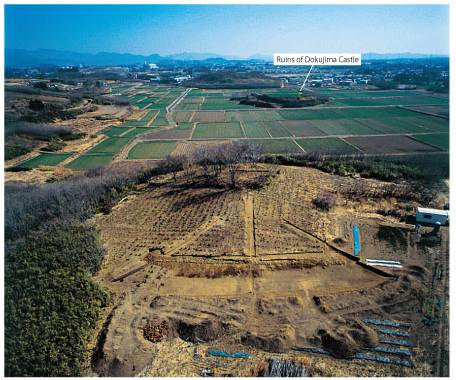
Akabori Chausuyama Kofun viewed from a distance (from the west)
The foreground shows the rectangular front section, while the circular rear section is in the background. Beyond the rice fields, the ruins of Dokujima Castle, considered the residence of a powerful clan from the Kofun period, can be seen.
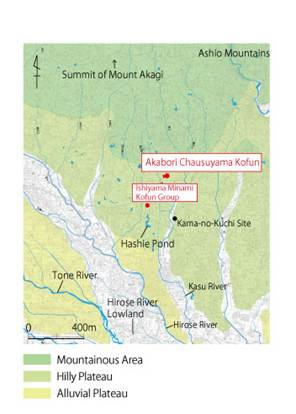
Site Location Map
Numerous small and medium-sized rivers flow through Isesaki City from Mount Akagi. In the northern part of the city, hills formed by the mountain’s collapse (commonly known as Nagareyama) are scattered throughout the landscape. The Akabori Chausuyama Kofun is situated atop one of these Nagareyama hills, while the Ishiyama Minami Kofun Group is located at the base of the Nagareyama (on a hilly plateau).
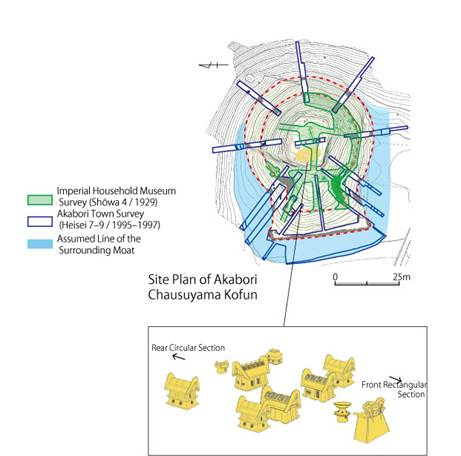
Diagram of the Imperial Household Museum’s Haniwa Arrangement (Shōwa 8 / 1933)
A schematic representation of the restoration proposal.
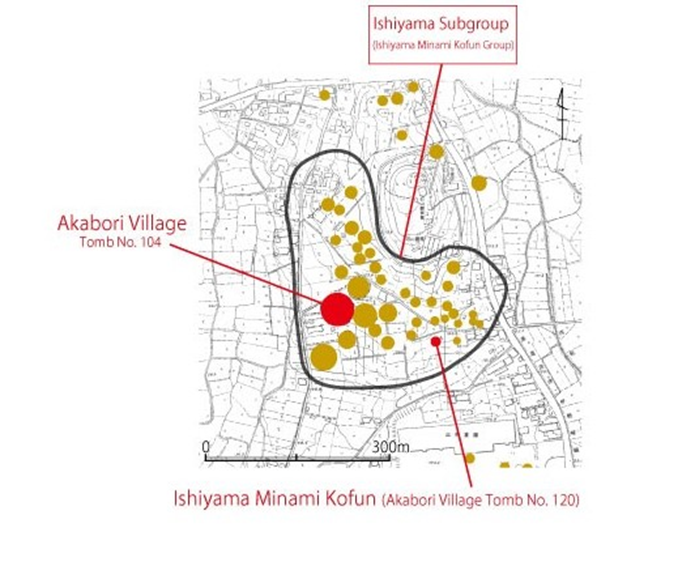
Distribution Map of the Ishiyama Minami Kofun Group
Over 100 tombs were constructed from the 5th to 7th centuries, extending from the hills to Hashie Pond, and are collectively referred to as the Shimofureichō Kofun Group. Based on the distribution, these tombs are divided into four subgroups. The Ishiyama Subgroup, consisting of 38 tombs, forms the Ishiyama Minami Kofun Group, which was constructed during the 6th century.
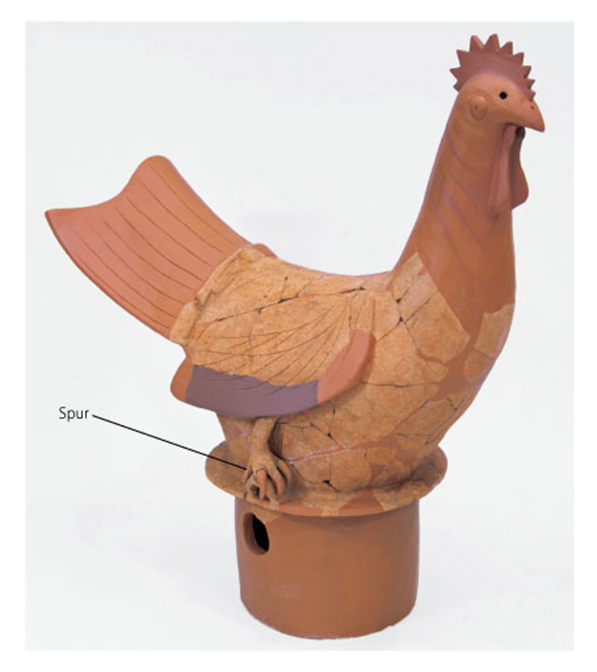
Rooster-shaped Haniwa Excavated from Akabori Chausuyama Kofun
The reconstructed head portion is estimated based on a comparison with items in the Tokyo National Museum collection. The darker area of the right wing corresponds to the part excavated from the Kama-no-Kuchi Site. Height: 86.4 cm, Width: 75 cm, Depth: 41 cm
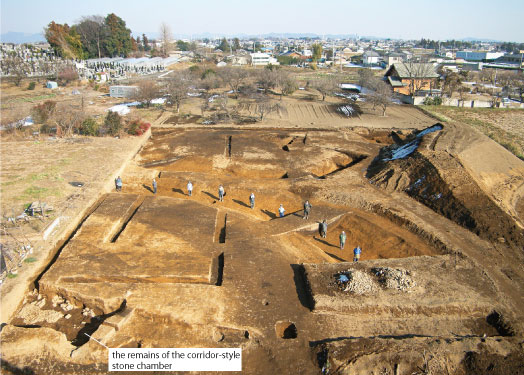
Akabori Village Tomb No. 104 (View from the West)
Approximately one-fourth of the entire tomb was investigated. The bottom left corner shows a corridor-style stone chamber from which the stone materials have been removed. The area where the person is standing marks the surrounding moat. A large quantity of haniwa fragments was excavated from the remains of the corridor-style stone chamber.
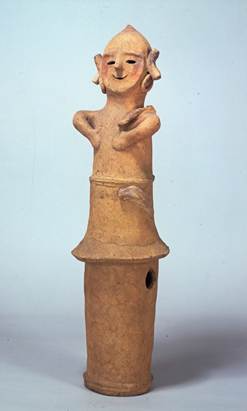
Man Carrying a Hoe
Housed in the Tokyo National Museum. Although this haniwa did not join with those excavated during investigations in Isesaki City, other haniwa from the same site did, confirming that it was excavated from Akabori Village Tomb No. 104. Source: ColBase (colbase.nich.go.jp)
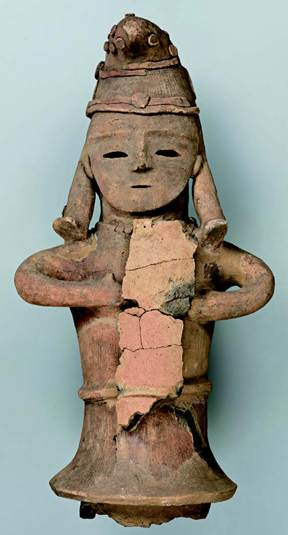
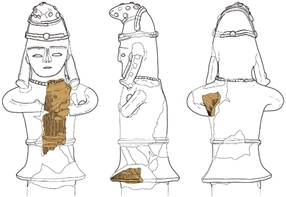
Human-shaped Haniwa from Akabori Village Tomb No. 104
One of four haniwa identified as belonging to the same original figure. The colored portions correspond to fragments excavated from Akabori Village Tomb No. 104, while the remaining parts are housed in the Tokyo National Museum. This is a large-scale piece. Although it is a half-length figure, traces of a detached large sword can be seen at the waist.
Height: 71 cm, Width: 35 cm, Depth: 27 cm
(Courtesy of the Tokyo National Museum)
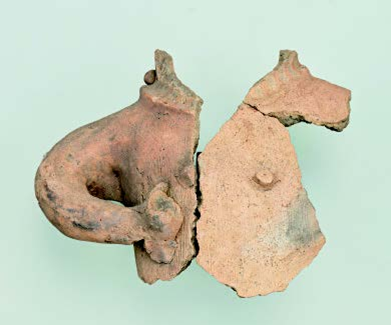
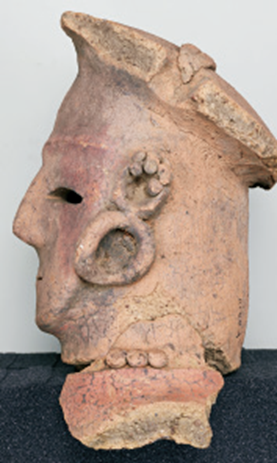
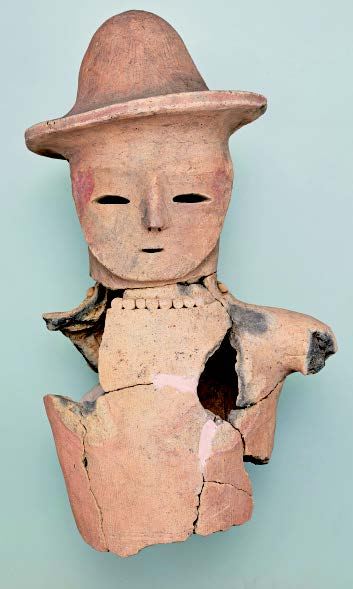
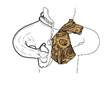
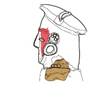

Human-shaped Haniwa from Akabori Village Tomb No. 104
The colored portions correspond to fragments excavated from Akabori Village Tomb No. 104, while the remaining parts are housed in the Tokyo National Museum. The red markings indicate areas where red pigment was applied. (Courtesy of the Tokyo National Museum.)
Left figure: Female, small size, height: 19 cm, width: 20 cm, depth: 15 cm.
Center figure: Female, large size, height: 29 cm, width: 19 cm, depth: 19 cm.
Right figure: Male, large size, height: 50 cm, width: 29 cm, depth: 21 cm.
